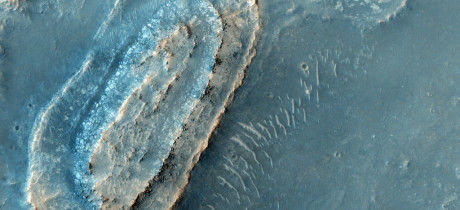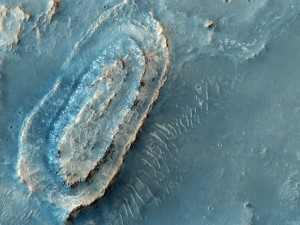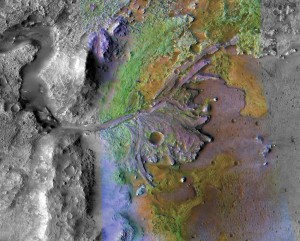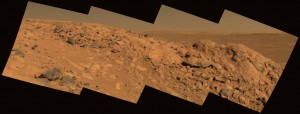If you were sending a spacecraft to another planet, how would you know where to land?
Last week, participants of a landing site workshop met to discuss just that for NASA’s 2020 rover that will land on Mars. The list of potential sites was narrowed down during the February 8-10 workshop held in Monrovia, CA.
Three sites were recommended for further evaluation: Northeast Syrtis, Jezero crater and Columbia Hills.
Northeast Syrtis is a very ancient part of the red planet’s surface. Bedrock that is more than 4 billion years old is exposed in this region and it contains a diversity of minerals that are hydrated.
The area was once warmed by volcanic activity, and heat sources from underground made hot springs flow and melted surface ice. In this liquid water that was in contact with minerals, microbes could have thrived. The interactions between water and minerals occurring over successive periods in the planet’s early history are recorded in this region’s layered terrain.
NE Syrtis, Image Credit: NASA/JPL-Caltech/University of Arizona
There was once a lake at a different potential landing site, Jezero crater. At least twice, the crater was filled with water and drained.
A lake was created when river channels spilled over the crater more than 3.5 billion years ago. Evidence observed by scientists shows that clay minerals from the surrounding area were carried by water into the crater after the lake dried up. During one or more wet times, it’s possible that microbial life could have lived in this crater.
Jezero Crater, Image Credit: NASA/JPL-Caltech/MSSS/JHU-APL
In the 100-mile-wide Gusev Crater, mineral springs once came up from Columbia Hills’ rocks. The Mars Exploration River, Spirit, discovered that this location had flowing hot springs. This was especially meaningful as the rover had not found signs of water anywhere else in the crater.
A shallow lake may have formed in Gusev Crater; evidence that past floods might have formed this lake was found through studies of Spirit’s older data. This was found after Spirit stopped working in 2010. The image below shows the plains and rim of the crater behind a rock outcrop.
Gusev Crater, Image Credit: NASA/JPL-Caltech/Cornell
With a launch targeted for July 2020, the Mars 2020 rover will perform geological assessments of its landing site. It will determine the environment’s habitability and look for signs of ancient Martian life. The rover will assess both natural resources and hazards for humans that explore Mars in the future. Furthermore, a collection of samples will be set aside by the rover that a future mission could possibly return to Earth.
Explore more about the rover: http://mars.nasa.gov/mars2020/mission/overview/




